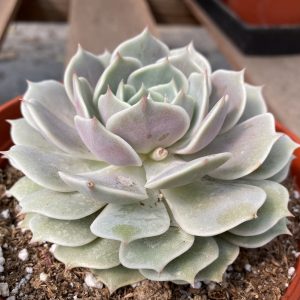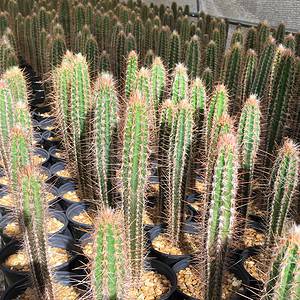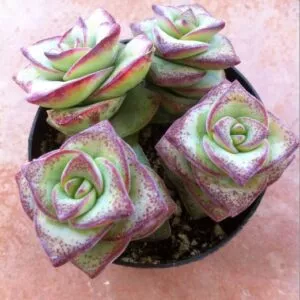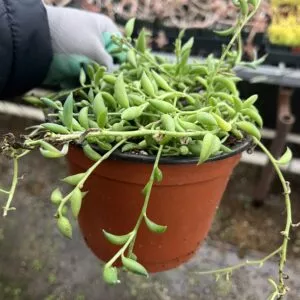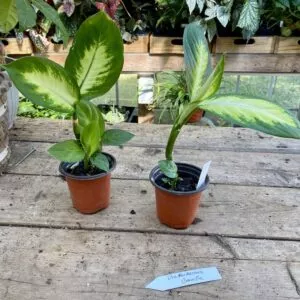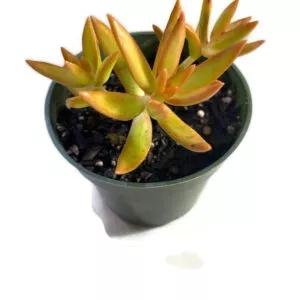No products in the cart.
Table of Contents
Did you know that the Citrus aurantiifolia does not only produce fruit but also flowers perfect for indoors? Lime flowers are small and star-shaped, with white or yellow petals. They are frequently grouped together.
Plus, its flowers have a pleasant scent! The tree rarely reaches a height of more than 5 meters (16 feet), and if not pruned, it becomes shrubby. It has irregularly spaced branches with short, stiff twigs and little stinging thorns.
Lime leaves are oval in shape and have whole edges. The leaves are lustrous and either light or dark green in hue.
Want to get more fascinated about this Lemon tree? Lime’s various nutritious ingredients, such as vitamin C, vitamin B6, vitamin A, vitamin E, folate, niacin, thiamin, riboflavin, pantothenic acid, copper, calcium, iron, magnesium, potassium, zinc, phosphorus, and protein, contribute to its health advantages. Flavonoids, which are compounds with antioxidant and cancer-fighting effects, are also found in lime.
It aids in the prevention of diabetes, constipation, high blood pressure, fever, and indigestion, and the enhancement of the skin, hair, and teeth.
Now, do you want to grow a Lime tree indoors? Well, I tell you that that is not a wrong choice! Here we will tell you how to take care of a potted tree!
Lime Tree Plant Care Basics
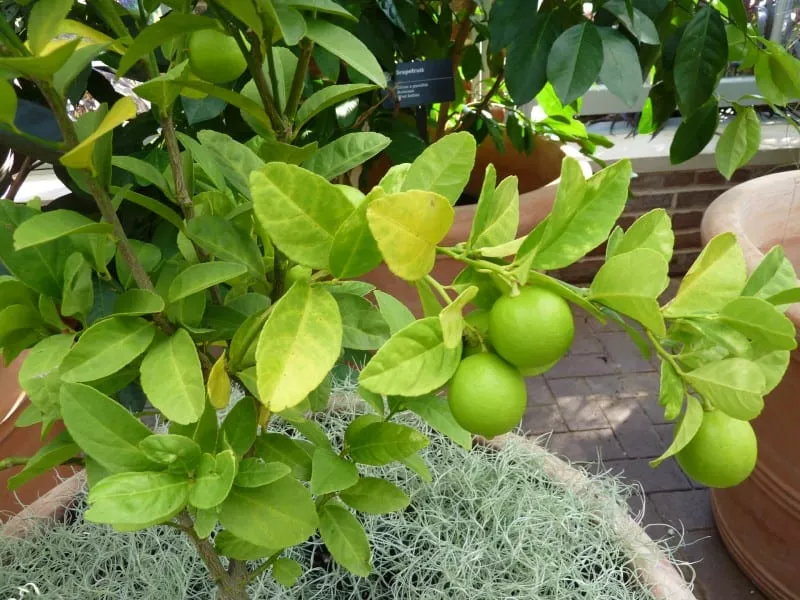
Before anything else, here’s a little overview of this Key Lime tree. I assure you it can be a great help.
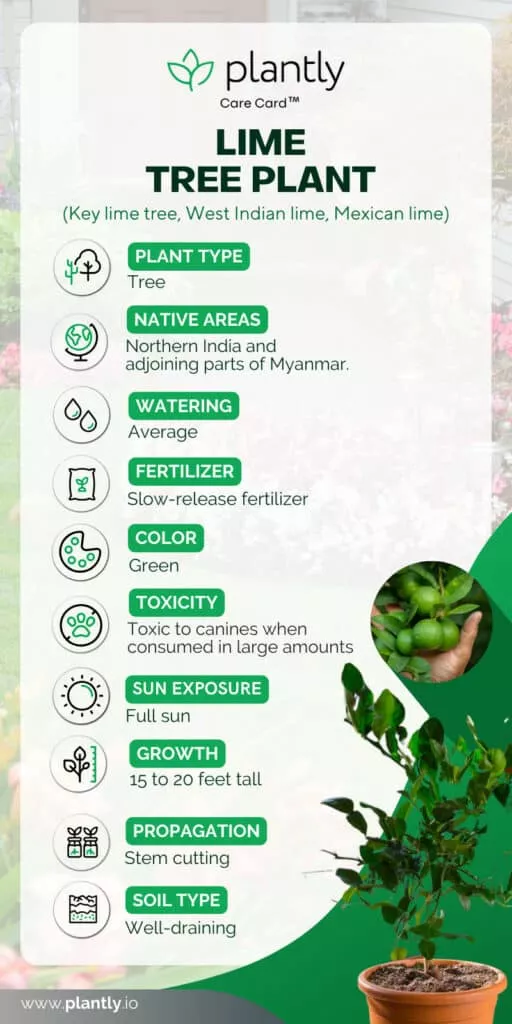
Now, are you excited to learn about the easy essential tips on how to take care of these Lime trees? Well, find a comfortable place, and let’s get started. Enjoy!!
Recommended Potting mix
Choose a good quality potting mix and line the bottom of the pot with pebbles to assist drain the soil if you’re planting your tree in a pot. The excellent quality of the potting mix should include well-draining soil and be rich in nutrients. If this tree are placed in inadequate drainage soil, they will eventually perish. Plus, they won’t grow in saline or heavy clay soil.
Lime tree Lighting Requirement

This health benefiting tree prefers full sun and ideally as an outdoor plant. Lime trees cultivated in even partial shade may develop straggly as they seek out a source of light. Choose a position that gets southern sun if at all possible if grown indoors.
When growing these trees in a container, you have the advantage of being able to be moved to a more sunny location if they are struggling. Plus, you can move them indoors if the weather turns cold.
In stock In stock Only 1 left in stock In stock
$59.99
Sold By:
Succulent Oasis
Mature Agave Lucky Crown Century Plant.
Rated 4.84 out of 5 based on 352 customer ratings00
Sold By:
Succulent Oasis
$10.99 – $29.99
Sold By:
Succulent Oasis
Medium Kalanchoe ‘Dragonfire’. A beautifully colored succulent.
Rated 4.84 out of 5 based on 352 customer ratings01
Sold By:
Succulent Oasis
$29.99
Sold By:
Succulent Oasis
Mature Succulent Plant Echeveria Lola.
Rated 4.84 out of 5 based on 352 customer ratings00
Sold By:
Succulent Oasis
$12.00
Sold By:
Cactus Island
Pilosocereus royenii (Puerto Rico dry forests)
Sold By:
Cactus Island
Watering Needs for Lime tree
Water your Lemon trees at least once a week for the first few months as it adjusts to their new position. After that, if you don’t get more than an inch of rain during the week, give it a drink. If the tree’s leaves begin to fall off, it may want additional watering, so check it every few days, especially during drought conditions.
Having said that, too much watering will also destroy them. The easiest way to care for the lime is to water them regularly but not excessively.
Pro tip: Lime trees don’t like to be entirely dry, so water it as soon as the first several inches of topsoil feel dry.
Ideal Temperature & Humidity

Temperatures between 55 and 85 degrees Fahrenheit (12.7 and 29.4 degrees Celsius) are ideal for Lime trees. That is obvious that they prefer warm weather and can only thrive in temperate settings all year. Because the minimum temperature it can endure is roughly 50 degrees Fahrenheit (10 degrees Celsius), so you’ll need to bring your Citrus trees inside if temps are expected to drop below that.
Pro tip: You need to bring your Lime tree inside when the weather becomes colder to get through the winter, then take it back outside when spring arrives. Because sudden temperature swings can injure the tree, keep it away from heaters, radiators, and outdoor doors.
Lime tree Necessary Fertilizer
Considered heavy feeders. They will swiftly deplete the soil in their immediate surroundings, whether in a container or in the ground. So, Lime trees require a steady supply of nutrients.
Use potassium-rich fertilizer for this magnificent tree for optimal growth. Each time, only a third of the suggested amount of fertilizer should be used. Scratch the powdered fertilizer into the top couple of inches of soil and water it in.
Then, you use the fertilizer less in the winter when they are dormant.
Pro tip: You can top-dress the area with enriched compost every few months, or you can feed your tree with a citrus-specific fertilizer regularly. Always see the package guidelines for frequency.
In stock In stock In stock In stock
$9.99
Sold By:
Succulent Oasis
Medium Succulent Plant – Crassula Perforata String of Buttons
Only 36 available and it’s in 2 people’s basket Rated 4.84 out of 5 based on 352 customer ratings01
Sold By:
Succulent Oasis
$14.99
Sold By:
BubbleBlooms
Blue Columnar Cactus, Pilosocereus pachycladus Cacti, Column cactus, tall blue torch cactus, in 2 inch square pot
Rated 4.81 out of 5 based on 279 customer ratings00
Sold By:
BubbleBlooms
$70.00
Sold By:
Andy Nursery
$75.00Red Finger Lime Grafted Citrus Tree. 2 Feet Tall.
Only 47 available and it’s in 1 people’s basket
Sold By:
Andy Nursery
$19.99
Sold By:
Cacti and Exotica
Senecio radicans | String of bananas | 6″ Pot
Rated 4.98 out of 5 based on 59 customer ratings00
Sold By:
Cacti and Exotica
Propagation
Ready to propagate your Lime trees? Don’t worry because we’ll guide you all throughout. Lime trees can be grown from seed, stem cuttings, or air layering. But here, we will only show how to propagate them using stem cuttings.
So, here’s how you will propagate your Lime trees:
- Choose a branch from a healthy lime tree that is free of disease and pests.
- 3 inches from the end of the branch, near where a leaf emerges from the stem, place your pruners along the branch (leaf node). To get rid of the branch, make a cut across it.
- Remove the lower two-thirds of the branch’s leaves. Dip the branch’s end in rooting hormone.
- Fill a peat pot halfway with water and peat moss until it’s as moist as a wrung-out sponge. Halfway into the peat moss in the center of the container, insert the stem.
- Place the peat pot on a sunny windowsill and cover it with a plastic freezer bag to keep the plant out of direct sunlight.
- To foster root growth, place the pot on a heated mat that keeps the soil at 70 to 75 degrees Fahrenheit (21. 1 to 23.8 degrees Celsius).
- When the plant’s roots sprout, remove the plastic bag. To keep the plant hydrated, mist it every day. And there you have it! A new beautiful Lemon tree.
Growth Zone
In the USDA zones 8 through 11, Lime trees grow best outside. Citrus trees can be planted outside in zone 8 as long as it is on the south or southeast side of the house for protection. Zones 9 and up can grow Citrus in their gardens without much extra protection.
However, it’s always a good idea to be ready to cover them in case of a sudden cold spell.
Potting and Pruning
When it comes to containers, plastic or polypropylene, for example, are non-porous materials that are good choices for a Lime tree. They maintain moisture and are lightweight, making moving pots indoors and out much more accessible. The pot should have numerous drain holes uniformly placed around the pot’s circumference instead of simply one in the middle to guarantee proper drainage. If necessary, drill additional holes.
Lime trees don’t necessitate a lot of pruning. Diseased or broken limbs and any branches that are rubbing against each other should be pruned back. You can cut back any branches that are too high if you want to keep your lime tree to a set size.
In stock In stock In stock In stock
$12.00
Sold By:
Smoot's Farm
Dieffenbachia or Dumb Cane Plant Camille 4 Inch Pot
Rated 4.89 out of 5 based on 27 customer ratings00
Sold By:
Smoot's Farm
$4.75
Sold By:
Cacti and Exotica
Parodia leninghausii
Rated 4.98 out of 5 based on 59 customer ratings00
Sold By:
Cacti and Exotica
$12.99
Sold By:
BubbleBlooms
Watermelon Pilea Cadierei, Aluminum Plant, 4 inch
Rated 4.81 out of 5 based on 279 customer ratings00
Sold By:
BubbleBlooms
$12.95
Sold By:
Orchid Stuff Plus
Sedum Adolphii ‘Firestorm’ Succulent in a 4 inch pot!
Rated 5.00 out of 5 based on 1 customer rating00
Sold By:
Orchid Stuff Plus
Lime Tree Varieties and Similar Plants
Lime trees exist in a wide range of forms, sizes, and colors. Lime varieties are a universe unto themselves, from the blood lime’s stunning scarlet rind to the long tubular Australian finger lime oozing caviar-like spheres! And we will provide some of those.
Here are they:
Mexican Key Lime tree
Mexican lime plants, often known as Key lime trees, produce one of the most prevalent limes in the United States. Their fruit, which has green flesh and is somewhat smaller than a lemon, is the most often encountered lime in supermarkets. This Citrus aurantifolia is also a fantastic alternative for gardeners in warmer climates searching for a tree that can produce both fruit and shade. It is a very cold-sensitive tree with a dense crown.
Persian Lime tree
The Persian lime tree and the Bearss lime are the most commonly sold type of lime in the United States. This extensively planted lime tree is a hybrid between a key lime and a lemon tree, and when fully ripe, it turns yellow. This tree can grow up to 20 feet tall and could have thorny branches for the home gardener.
Australian Finger Lime
The caviar lime, Microcitrus australasica, is named for the little spherical insides of the fruit, called vesicles, that seeps out when a mature finger lime is split open. This citrus tree is native to Australia and has a 3-inch tubular dark green surface. The interior is lengthy and pastel green. These fruits are becoming increasingly popular in cocktails and other high-end beverages.
Lime Tree Plant Diseases & Pests
Pests are kept at bay by the colder temperatures outside, but lime trees grown as indoor plants are susceptible to common pests. Aphids, citrus whiteflies, and citrus thrips are the most common insects found on lime trees. Spinosad-containing insecticides can be used to control these pests. This insect spray has been approved for use in organic environments.
Citrus canker, a bacterial ailment controlled with a copper fungicide, can affect lime trees. Melanose, greasy spots, and sooty mold, which causes blackened leaves, are all controlled by this fungicide. Before using the fungicide, remove any affected leaves.
Most importantly, provide your Lime trees with the ideal condition they deserve to avoid more complicated problems in the future.
Frequently Asked Questions
In 3 to 6 years, seedling Lime trees begin to blossom and fruit, and in 8 to 10 years, they reach maximum productivity. Fruit is collected twice a year, in May and June and November and December.
Absolutely no! Most lime trees are self-pollinating, so you don’t need two to receive fruit. This indicates that the blooms have both a male and a female component. Self-pollination, on the other hand, does not guarantee pollination.
There are many factors in which your Lime tree is not producing fruits. Failure to fertilize the tree in August and February. And due to insufficient watering causes the plant to dry out. To prevent fruit drops, water them once a week for at least 15 minutes. Fruit drop can also be caused by prolonged wet weather.
You can now buy a Lime tree here at Plantly! Don’t worry if this is your first time ordering here because we ensure that we provide faster transactions online! Don’t miss this opportunity and contact us now!
Whether you want to buy, sell or simply reach out to other plant enthusiasts, Plantly is the right place to be!
-
$59.99Sold By: Succulent Oasis
In stock
Mature Agave Lucky Crown Century Plant.
Rated 4.84 out of 5 based on 352 customer ratings00Sold By: Succulent Oasis -
$10.99 – $29.99Sold By: Succulent Oasis
In stock
Medium Kalanchoe ‘Dragonfire’. A beautifully colored succulent.
Rated 4.84 out of 5 based on 352 customer ratings01Sold By: Succulent Oasis -
$29.99Sold By: Succulent Oasis
Only 1 left in stock
Mature Succulent Plant Echeveria Lola.
Rated 4.84 out of 5 based on 352 customer ratings00Sold By: Succulent Oasis -
$12.00Sold By: Cactus Island
In stock
Pilosocereus royenii (Puerto Rico dry forests)
Sold By: Cactus Island


